I always like to weld as perfectly as possible. It requires best quality welder machine, best quality filler metal and other tools & accessories. As a professional welder I always recommend branded welder machines for obvious reasons.
People keep asking me which Mig welder to use to get a professional result. The answer can’t be a single machine. I have listed 6 best professional Mig welder machines that are best for high quality, heavy-duty welding work. Find them out bellow-
Professional Mig Welders List
- Miller Millermatic 211 MIG Welder (Best overall)- $2009
- Lincoln Electric Power MIG 211i MIG Welder (Best For Value)- $1299
- Hobart 500553 Handler 210 MVP MIG Welder (Editor’s Choice)- $1150
- YESWELDER 205DS MIG Welder (Best For Money)- $360
- Forney Easy Weld 140 MP (Best Multi-process Mig)- $420
- LOTOS MIG175 MIG Welder (Best For DIY’s)- $289
Why trust us:
We have listed the welders based on our hours and days of research with the machines. We also collected reviews from actual users to take their opinion over the machines. We have conducted a mail campaign also to collect information from producers. We have tested some of the machines as well.
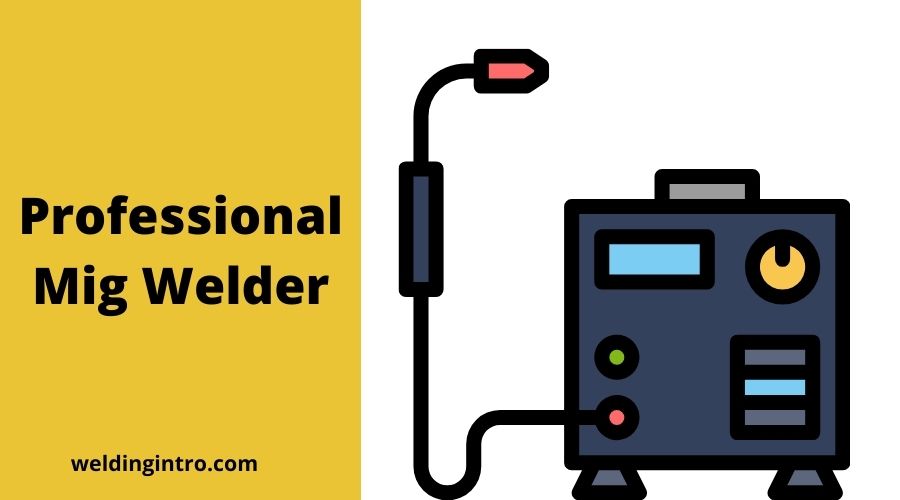
1. MILLER ELECTRIC MIG Welder (Best Professional Welder)
Mig welding has a long history so as the Miller welder. Reliability is something that a brand can only build with time, and MILLER is one such brand. Some of the best welder specialists rely on this MILLER MIG welder, and there are good reasons why they do it. I also love Miller welders for their consistent quality welding. That why I have ranked it number 1 in my list.
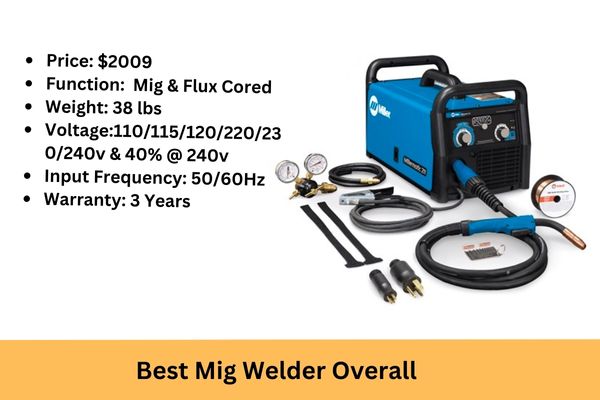
This welder can easily weld from 18 gauge to 3/8″ of thickness of aluminum & 24 ga to 3/8″ mild steel & 20 ga to 1/4″ stainless steel. The welder is 38 lbs in weight and can handle 110v, 120v, 220v and 240v input voltage which provides you with flexibility and saves you money.
- Material Thickness: up to 3/8″ Aluminum, up to 3/8″ mild Steel & up to 1/4″ stainless steel
- Input Amperage: 17 amps
- Voltage: 240VAC
- Output Range: 30-230A DC
- Duty Cycle: 40% @ 240v and 20% @ 120v
- Warranty: 3 Years
The advanced auto-set feature of this MILLER welder can be a blessing for beginners since it automatically calibrates the welder according to the job. Of course, you can also manually set the welder, but this feature allows you to use the welder right out of the box.
The price is well justified considering the performance of this dual voltage welder. You should be able to handle any demanding welding job with it easily. While DC output can generate up to 230 amps, that number comes down at 150 with AC output. The dual voltage allows you to switch between both power options according to your need.
Miller provides a 3 years warranty with the machine, that’s why I am confident about the welder. It comes up with a M-10 mig gun with 10ft cable, a work clamp, a gas hose, a 0.030″ solid wire, 0.030″ contact tips and a metal thickness gauge.
You can operate Miller Mig welder with 7000 watt generator at full scale, which is amazing. For inverter technology the variation of travel speed and length doesn’t impact the weld arc. It lays perfect weld bead at any welding position.
About 85 people have reviewed it positively and given 4.7 star out of 5 on average. One customer named Wayne has said, he has laid the best bead ever in his life in first pass with the welder. He loved the welder very much and given 5 start for its light-weight, quality weld and deep penetration.
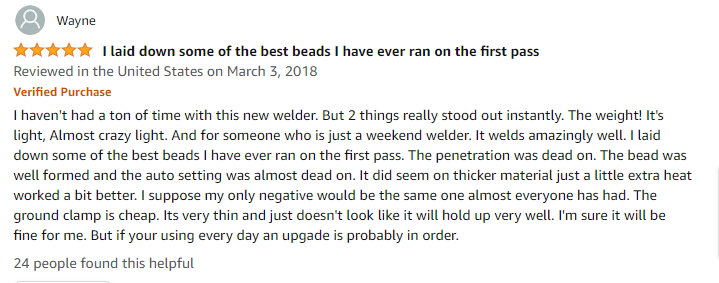
The machine is portable and strong as well. The outer shell is quite durable with a plastic and steel construction. The controls are located at the front of the welder, and the top-handle makes sit super easy to move. Though the price of the machine is huge ($2009), for better penetration and quality weld as professional you must invest in good welders.
This MILLER MIG welder has already established its name with performance, quality, and portability. If you want a welder to use for years, you can invest in this welder blindly. I guarantee this welder won’t disappoint you.
2. Lincoln Power Mig 211i Welder
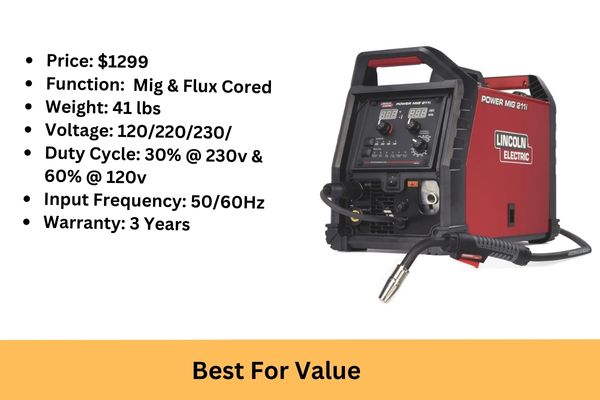
My second choice is, my favorite welder model Lincoln 211i Mig welder. I personally use it in every heavy-duty works I do and my love for the machine is surging day by day.
Lincoln mig welder holds simple interface with seven segment display. Its ergonomic design helps you to easily carry the machine anywhere you want.
- Weight: 41lbs
- Duty Cycle: 30% at 230v and 60% at 120v
- Input Amperage: 20amps
- Output Range: 20-211A
- Warranty: 3 Years
The machine is best for value. You can weld metals of any thickness with the machine. For application, almost every project you can handle with the machine ranging from general fabrication, automobiles welding & construction to maintenance and repairing service.
The welder hold duel voltage facility that helps you to weld with duty cycle 60% @ 120v input and 30% @ 230v input voltage. That means if you are welding for 10 minuets, you can weld for 6 minutes continuously at 120v power. At the other hand if you are powering the welder with 230v input, you can weld continuously for 3 minutes.
The welder comes up with a magnum pro 100 mig gun, an adapter for 120v and 230v range, a work clamp, a gas regulator, a 0.030″ mild steel wire spool and an installed drive roll (.030-.035″).
About 17 people has reviewed the welder and given 4+ stars out of 5 on average. The welder is good but sometimes the seller can make mistakes and ship damaged one. You may return the product if it comes in damaged package or any problem you see. One rater named J. Woody says that, the machine is best for welding 1/4″ even 1/2″ material. Easy to setup and perfect for heavy-duty work. He says the welder needs to learn the basics of welding before start working with the welder machine.
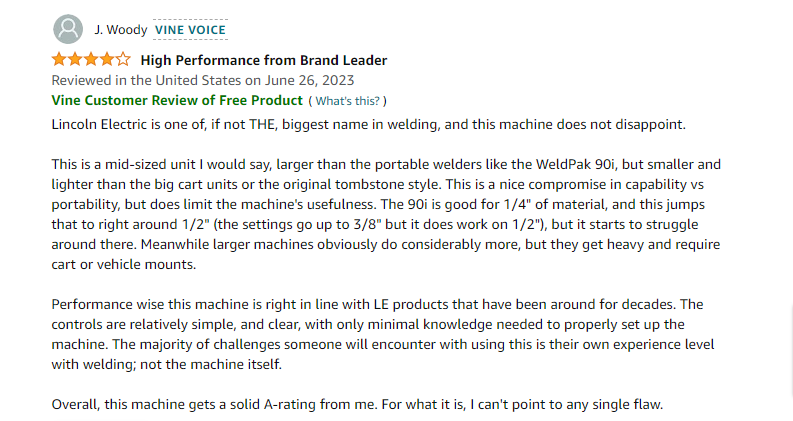
I can guarantee the quality of the welder as I am using it for more than 5 years. You won’t face any problem using it if you are familiar with basic mig welding. The product is priced at $1299 which is a decent price for that type of machines, I think.
3. Hobart 500553 Handler 210MVP MIG Welder
Hobart has been an established player in the field of MIG welders. This time their 500553 Handler 210 MIG welder again proves why they are so popular among welders. I have ranked it 3rd for its quality and outstanding features.
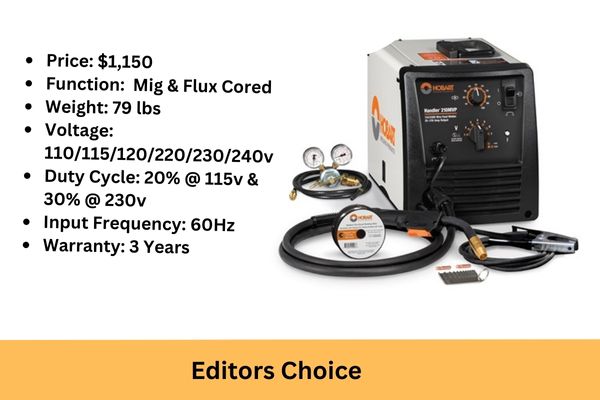
- Thickness Of Weld: 24 gauge upto 1/4 Inches mild steel
- Duty Cycle: 20%@ 115v & 30% @ 230v
- Wire Feed Speed: 40-770IPM
- Voltage: 115v, 120v, 220v, 230v & 240v
- Material : Aluminum, Stainless Steel, Mild Steel
- Warranty: 3 Years
Hobart 500553 welder offers a 5-position voltage adjustment. So, you can easily control the voltage according to the project demand.
The machine can easily weld from 24 gauge up to 1/4 in mild steel with ample power. Welding compatibility materials are pretty decent as it supports steel, stainless steel, and aluminum welding. You can use the welder for mig and flux core welding process.
The wire selector is another crucial addition to this amazing welder. It basically allows the user to control the wire feed speed between 40-700 IPM with load and 50-740 IPM without load. The quick selector drive roll offers three grooves; two for solid wires & one for flux core wire, that makes it faster in wire feeding. You can easily fine-tune wire speed thanks to seven position voltage control selector on the machine.
All the controls and knobs are located at the front of the machine so you can control the machine and welding process easily.
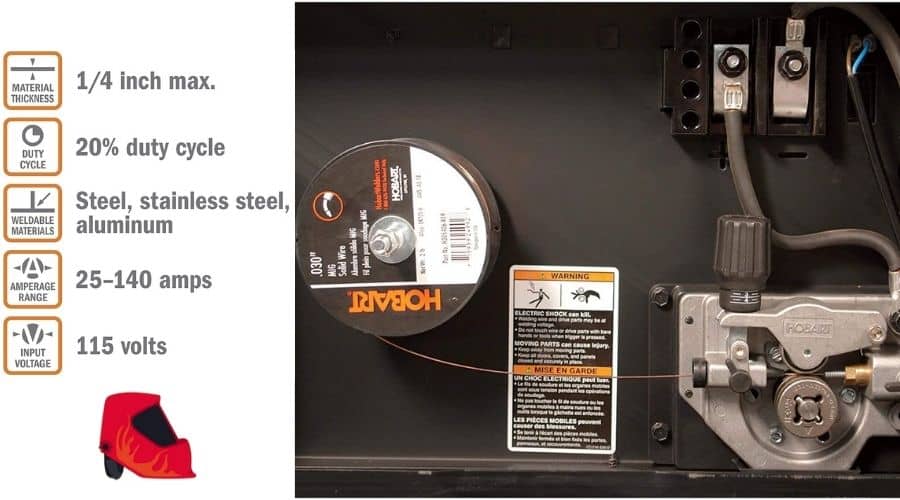
Five hundred and twenty four people have appreciated the product in amazon rating it 4.7 out of 5. One rater named Over.A.Cliff advised to cool down the welder when it is hot. He has recommended the product for home use as well as garage use.

All in all, there is not much left to complain about this amazing MIG welder except for the welder is not compatible with generator compared to other welder options in this guide. To tackle the problem, replace the transformer with solid state inverter. It has the perfect balance of affordability and performance, which most welders look for.
4. YESWELDER Digital MIG-205DS MIG Welder
YESWELDER is primarily known for its high-quality welding helmets. It has been a decade since, they decided to enter the welder machine market & they seem to continue their reputation. Yeswelder is producing world best welder machines specially mig welders that surprises the professional to newbie welders.
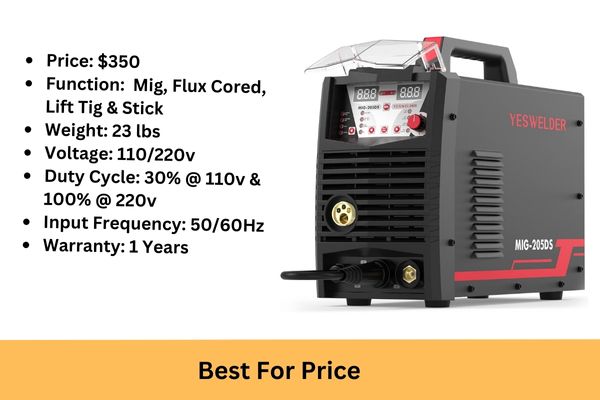
- Amperage Range: 30-205Amp
- Duty Cycle: For 110v input- 60% @160A & 100% @123A ; For 220v input- 60% @200A, 100% @154A
- Voltage: 110v/220v 50/60 Hz
- Plug: 110V/220V
- Warranty: 1 Year
This MIG-205DS is a budget welder. It has many features that even high-end welders miss today. The welder is a dual voltage and variable amperage welder, with capability of welding with 110 and 220 volts at 30 to 205 amps.
For that price $360, the amount of penetration you’ll get is amazing. The arc creation is immediate, and the welding has the minimum amount of spatter.
On top of that, the digital display makes the control experience more convenient. YESWELDER also had a special focus on safety, and the addition of over-heat and over-voltage protection proves that.
The welder can handle Mig, flux core, Arc and Lift Tig welding process in a single unit. It can weld stainless steel, Carbone steel, aluminum and even galvanized steel easily and perfectly. It contains a mig torch, a LBT150 spool gun, two gas hose, a 10′ earth clamp, a 10′ electrode holder, a graphene tube and wire feed drive roll.
You can shift the mode of welding from 2T – 4T by pressing right knob twice. You know 2T helps to weld thinner while 4T is used to weld thicker metal.
Alongside MIG welding, there is an option for true lift TIG welding. But for that, you’ll have to buy a TIG torch separately. YESWELDER WP-17V-35 tig torch is recommended to use for tig welding with the welder.
YESWELDER MIG-205DS was fairly compact and portable with a dimension of 20 x 16 x 11 inches and a weight of 35 pounds.
On top, there is a handle for handling. The digital display also has a hood-like cover. The rest of the construction is made of steel.
About 2113 people have reviewed the machine in Amazon and given 4.5 start out of 5. One rater named Justin has said that he has used the welder for 1/4″ and 1/8″ steel and he succeeded without any issue. He suggested to use 0.030″ wire for mig welding also you can use 0.035 & 0.023″ wire (see the manual). With auto setting you can do the work but if you want more control, change the setting according to the manual.
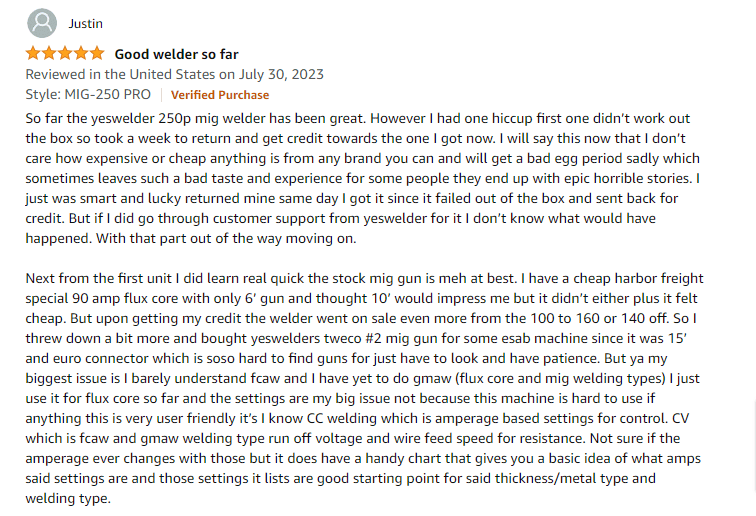
YESWELDER is doing an amazing job with its performance as a new brand in the MIG welding scene. Moreover, you are getting MIG, TIG, and ARC welding all in one, making this welder a really great value.
5. Forney Easy Weld 140 MP welder
Forney Easy Weld 140 is an excellent welder hard to beat in terms of sheer value. At a fraction of the cost of its competitors, it can generate high-quality welding. This welder is targeted towards beginners.
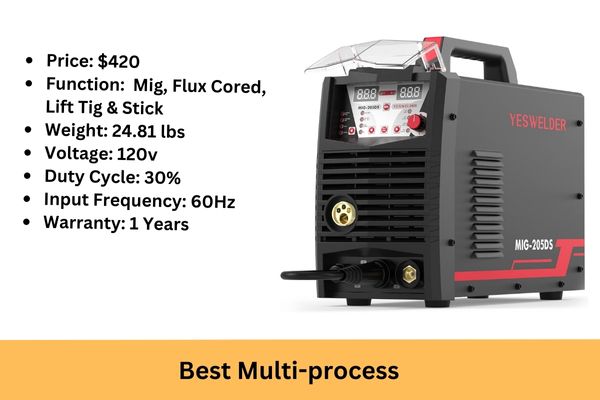
- Output: 140 Amp
- Input: 120v
- Material Thickness: up to 1/4 inch mild steel
- Plug: 20A-15A adapter
- Duty Cycle: 30%
- Warranty: 1 Year
There is a rating of 140 amps, an excellent number compared to higher-priced competitors. With its help, you can easily weld material up to a thickness of ¼ inch. The duty cycle of 30% might not be the highest, but it’s impressive for the price. Also the welder offers multi-process functionality that increase flexibility. It can do Mig, Flux core, Stick and Tig welding with a single welder.
It contains contact tips, nozzle, gas diffuser, mig wire, flux wire, a 10′ mig gun, a 8′ electrode holder, ground clamp, and 15-20a adapter.
808 people have reviewed the welder and given 4.7 rating out of 5. One customer named Beeteam2557 has appreciated the welder for its auto tuned settings and nice beads. He has suggested to plug the welder into positive socket and ground clamp into negative for running mig welding process.
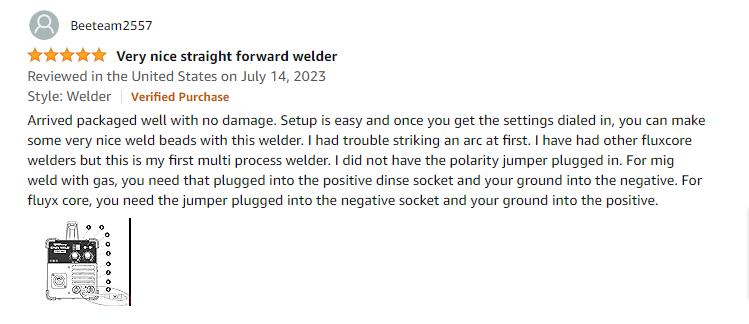
For beginners, initial setup often proves to be a huge challenge. Forney seems to solve that problem by providing an easy setup. Getting the welder out of the box from welding only takes around five minutes.
So, I don’t think the advantage of portability and easy storage doesn’t need to be mentioned. The outer shell is plastic and steel with Forney’s trademark parrot green color.
This Forney Easy Weld 261 is a great choice for beginners who don’t want to invest much at first. The lower amperage setting can be very handy for learning the art of MIG welding. The price can lead to some second thoughts, but they are cleared by thousands of good reviews from satisfied users.
6. LOTOS MIG175 MIG Welder (Best for diy projects)
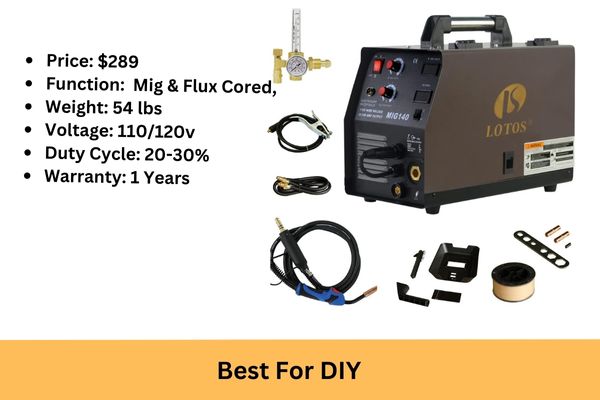
If you are open to trying out a MIG welder from a comparatively lesser known brand, we recommend you try this LOTOS MIG175 MIG welder. There are quite a few reasons that make this welder a great recommendation.
Firstly, LOTOS welder has an input voltage of 220/240V. With this amount of power, the welder can easily weld stainless steel up to ¼ inch in thickness and aluminum up to 3.16 inches in thickness.
This machine can handle demanding industrial welding jobs and DIY projects both. Moreover, the overheat protection works as a guard to guarantee this welder serves you for a long time.
The welder can weld 24 gauge – 3/16″ stainless steel and mild steel with 120v input power. It contains a mig torch, a ground clamp, argon regulator and gas hose, 0.025-0.030″ wire and contact tips ranging from 0.023-0.035″.
- Thickness OF Weld: For steel= 18 Gauge – 1/4″, For aluminum=3/16″
- Duty Cycle: 20% @175A & 30% @135A
- Spool Gun: 10 feet 4 inches long with diameter 0.9 millimeter
- Voltage: Runs in 200-240V
- Good For: Stainless steel, aluminum & mild steel
- Warranty: 1 Year
For a budget welder, LOTOS has built this welder like a tank. The welder has a dimension of 18 x 12.5 x 10.5 inches and weighs around 85 pounds. This weight can be a turnoff for welders looking for a portable machine. However, the whole thing is made of metal, so durability is guaranteed.
You can weld in 2T and 4T mode with the welder. 4T mode provides semi-auto welding that reduce your finger work.
About 524 customer have given 4.6 rating out of 5 for the welder. Racket Chen says, the welder has kept its promise. He has perfectly welded 5356 aluminum. Though he has complaint that the welder is heavy and its current flow is bit low for his work, the welder provides best performance overall.
It’s not an easy job to get the perfect balance of performance and durability, and LOTOS has done that fantastically. Moreover, the addition of a spool gun makes it an appealing option for budget welders. I suggest you buy the welder for your diy works. For heavy-duty works, welding more that 6mm plates, you should go for miller welder.
Advantages and Disadvantages Of MIG Welding
There are several arc welding methods, and MIG welding is considered the easiest. This technique has several benefits that make it so popular among welders.
But at the same time, there are some limitations that you need to consider before you choose MIG welding. The list of advantages and disadvantages below will help you make the decision.

Advantages of MIG welding
- The first advantage that will come to a professional welder’s mind is the speed of MIG welding. If you compare MIG welding with other methods (stick, tig, flux core etc.) it will win most of the time because the electrode is continuously fed. Minimum slag removal time also helps with the time efficiency of MIG welding.
- MIG welding is very easy to perform, which is a big plus point for novice welders. In addition, several steps of the MIG welding are automatic, and the one-handed torch makes the usage super easy. That’s why MIG welding is considered the best method for beginner welders.
- Versatile welding material is another advantage we need to mention. The penetration is already great for MIG welding. You’ll get exceptional welding results with good penetration, no matter the material. This deep penetration also ensures that the welding goes perfectly.
- MIG weld is well-known for its clean welding results. There is no flux in MIG welding to contaminate your welding, thanks to the shielding gas. As a result, there are minimum slugs to clean. This clean welding also lets you weld faster instead of cleaning the slug.
- If you have a small welding project, this might not benefit you. But for longer welding projects, the long-pass welding capability of MIG welding can be a great help. With other welding techniques, you might need to stop and start often, which is not the case for MIG welding.
- MIG welding is all about efficiency, and it’s clear from the minimum loss of electrode wire and alloying element. The credit again goes to the shielding gas, which protects the arc, and there is almost no loss of alloying element as the arc forms.
Disadvantages of MIG welding
- The higher cost is the biggest disadvantage of MIG welding. Let us explain why. MIG welding equipment is already pretty expensive, increasing the overall cost for starters. Next up, there is other additional stuff you’ll need shielding gas, extra tips, and electrodes that add up to the cost.
- MIG welding is not a great option if you plan to weld outside. MIG welding uses gas most of the time, and the wind outside can ruin that gas shield. Therefore, the quality of the welding can be affected. Therefore, it’s best if you don’t choose MIG welding for outdoor welding.
- Deeper penetration can be a potential issue for MIG welding. In demanding welding jobs, you might need to weld thicker pieces of welding materials. On the other hand, MIG welding is more suitable for delicate welding with thinner materials.
- The portability can be an issue since many additional accessories are needed to perform MIG welding. For example, you have to carry welding gas, a roll of wire, and the welder itself is pretty heavy to carry around. So, MIG welding might not be a good option if your job requires portability.
- Burh through and undercutting is very common MIG welding. However, since MIG welding has a constant voltage output, ting welding materials often get burnt if you are not careful. Also, the gas often fails to protect the tungsten, resulting in reduced cross-section thickness.
- MIG welding takes a longer preparation time. Apart from compiling all the accessories and equipment, you also need to prepare the material by cleaning the rust and dirt, which can be time-consuming.
MIG welding process (step by step)
As I mentioned earlier, MIG welding is super easy to perform with the right technique. If you are new to welding and wondering how to MIG weld, the step-by-step guide below will help you.
- Step 1: The first step to starting MIG welding is to wear safety gear. Every type of danger, including heat, electricity, and bright light, is involved in MIG welding. Without proper gloves, eye gear, and other necessary safety gear, MIG welding can be dangerous.
- Step 2: After ensuring safety, it’s time to calibrate the MIG welder. If the machine is new, take some time to know the welder thoroughly. Then according to the project, set up different perimeters according to your project.
- Step 3: MIG welding needs shielding gas, so make sure the regulator and gas cylinder work perfectly. The regulator has an adjustment screw that adjusts the gas pressure. Keep that loose so that rotating it is easier when necessary.
- Step 4: Before starting, some preparation is necessary for optimum welding results. Weld in a place with enough space and air nearby to avoid the toxic fumes. Preparing the welding materials I also necessary. Make sure there is no rust or blemishes on the surface.
- Step 5: At this point, you are ready to turn the MIG welder on. So, use the power cord and do it. Most welders have the wire feed speed and voltage setting at the front. Use those controls and set the necessary value. The welder can melt through the material if the value is set high. So, it’s always best to start low.
- Step 6: Just checking whether the feed wire inside the gun is not enough; also make sure the amount of wire is sufficient. If the wire is too long, cut it to the right size. Press the trigger once to ensure there is no problem, and the wire is through.
- Step 7: Start welding by lowering your helmet or facemask. You can use the push or pull technique according to your comfortability. It’s usually best to start from the top of the weld and then end at the bottom. After welding is finished, set the wire feed to the lowest setting.
- Step 8: You need to prepare to turn off the welder in this step. Start by closing the cylinder valve and bleeding the regulator to zero. After all, these are done, turn off the welder and unplug it from the power socket.
Buying Guide
MIG welders are very complex tools; there is no doubt about it. Moreover, different models often come with different features and controls, making sit confusing for users to choose the right unit.
Below, we have compiled a list of factors you can use to find the best welder for professional MIG.
Power Supply & Power Cord
This is a basic consideration to make since you won’t be able to run the MIG welder properly without a proper power supply. Moreover, it can result in electric accidents too. Different welders utilize different voltages according to their purpose.
So make sure the welder you choose can run with the power socket at your house or workplace. Also, make sure the power cord is long enough to handle your need. Otherwise, it can limit your welding experience.
Live Torches
Torch plays the most crucial role in MIG welding as it does the main job of welding. Now, there are two types of torches available in MIG welding. Either you can use a live torch or opt for a trigger-mounted torch.
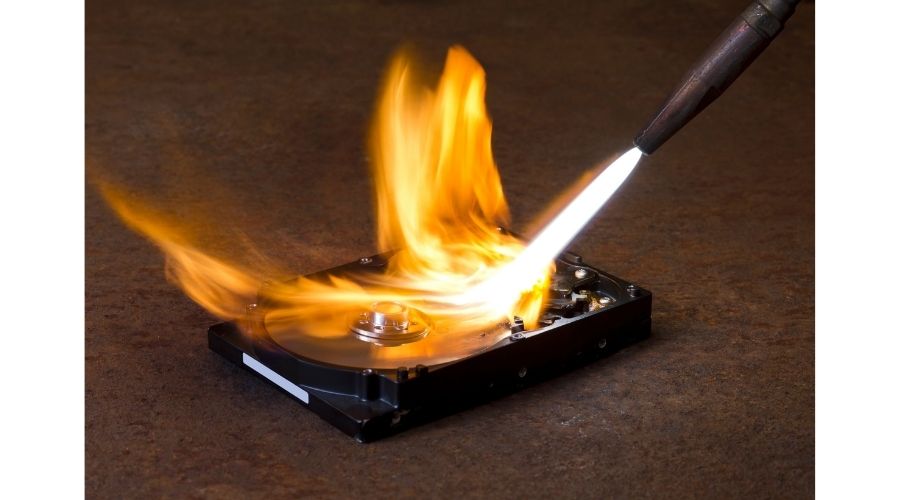
On the trigger-mounted units, you have the option to pull the trigger to start the weld. But on the other hand, live torches always generate uncomfortable heat and sparks, which can be harmful to the user’s eye.
So the best thing to do here is to avoid live torches for more control.
Duty Cycle
The duty cycle means the duration of the weld at one go. So, if your welding projects need you to keep welding continuously, you need a MIG welder with a higher duty cycle. The duty cycle is normally shown in percentage of 10 minutes.
So, if the duty cycle is 50%, you can operate the welder for 5 minutes straight, and then it’ll need a cool-down time of 5 minutes.
Gas Cylinder
It’s not necessary that MIG welding will always require gas to operate. For example, if you are welding outdoors, you don’t need gas for the optimum welding results. However, things changes if you are welding indoors, where the look of the weld matters.

So make sure the MIG welder you are buying has a gas cylinder.
Regulator
Regulators, also known as gas flow meters, are important to overlook the cylinder’s gas flow and control it. Though the welder has a recommended gas flow, you’ll need a regulator for accurate numbers. Different gases have different regulators, so make sure you use the correct regulator according to the gas.
Drive rolls
The importance of drive roll is somewhat the same as contact tip. For optimum welding, you have to keep the drive roll clean. Welders are often sued outside in harsh conditions.
As the wire passes through the drive roll to feed, it often has dust buildup. You can clean the buildup by using a vacuum.
Contact tips
No one wants to weld full of spatter. For that, a clean contact tip plays a very important role. If the contact tip is not enough, you won’t achieve the desired welding result, and it can cause porosity.
Moreover, there is a chance of reducing the gas flow due to the spattered contact tip. So make sure the contact tips are clean. If you want to keep the contact tip clean, using nozzle dip is a great idea.
Feed Speed
Feed speed is just what the name implies; it indicates how fast the welder can feed the wire through the torch. This speed is important because you don’t want to mess up your welding with too much sputter.
For best results, pick a MIG welder that offers both fast and slow feeding with variable speed control.
Safety features of MIG welding
As I mentioned earlier, MIG welding involves every kind of risk. So, you need to consider the safety features carefully to avoid any accident. A safety feature that you must look for is thermal overload protection.
MIG welder often gets overheated, and the protection can help you avoid damage by turning it off. You should also check out the cooling capacity and how the fan performs. An effective fan can easily prevent thermal overload from happening.
Correct amperage for MIG welding
Again, there is no correct amperage for MIG welding. The question here should be more like this, what’s the correct amperage for a certain thickness and material.
In MIG welding, the general rule of thumb is that every 1 amp of power will weld 0.001 inches of steel. You can have an estimate from there.
How thick can a 90 & 150 amp MIG welder weld?
The amperage mostly decides how thick a MIG welder can weld. Among the wide range of MIG welders, 90 and 150 amp are two of the most common ones. While 90 amps can weld from 1/8 inch to 3/16 inch, the 150 amp welders can do almost double that, depending on the material.
Of course, you can also weld thicker, but that’ll require more than a single pass.
How many amps is a good MIG welder?
There is no straight answer to this question since it’s completely subjective and depends on many factors. A MIG welder can easily go from 60 to 400 amps, and which one will be good for you depends on the material and thickness.
The rule is simple the thicker and stronger the material, the more amperage you’ll need.
FAQs (Frequently Asked Questions)
Q: What’s better, Hobart or Lincoln?
A: Both Hobart and Lincoln are established players in MIG welding. If we take their 140 amp MIG welder, there are many similarities in the feature set. Which one will be better for you depends on your preference.
While Lincoln 140 is better at penetration, Lincoln 140 offers a wider amperage control. Depending on which advantage you prefer, you should choose the better option.
Q: What is better, Lincoln or Miller?
A: Both Lincoln and Miller are equally popular in the welding industry. So, picking a winner might not be an easy job. If you are into MIG welding, Miller seems like the better choice overall. On the other hand, Lincoln is a suitable option for stick welding.
From the cost point of view, Miller is a bit more expensive than Lincoln too. Lastly, Lincoln seems to have the leading in terms of build quality and ease of use. All their welders are made for user-friendliness and longevity.
Last Words
That’s a wrap for today. I hope my review on professional MiG Welders comes in handy to make a decision. See, there are a lot of factors to consider while purchasing a MIG welder, and everyone prioritizes different factors.
So, all you have to do is get your priorities straight and pick the welder most suitable for yourself.
